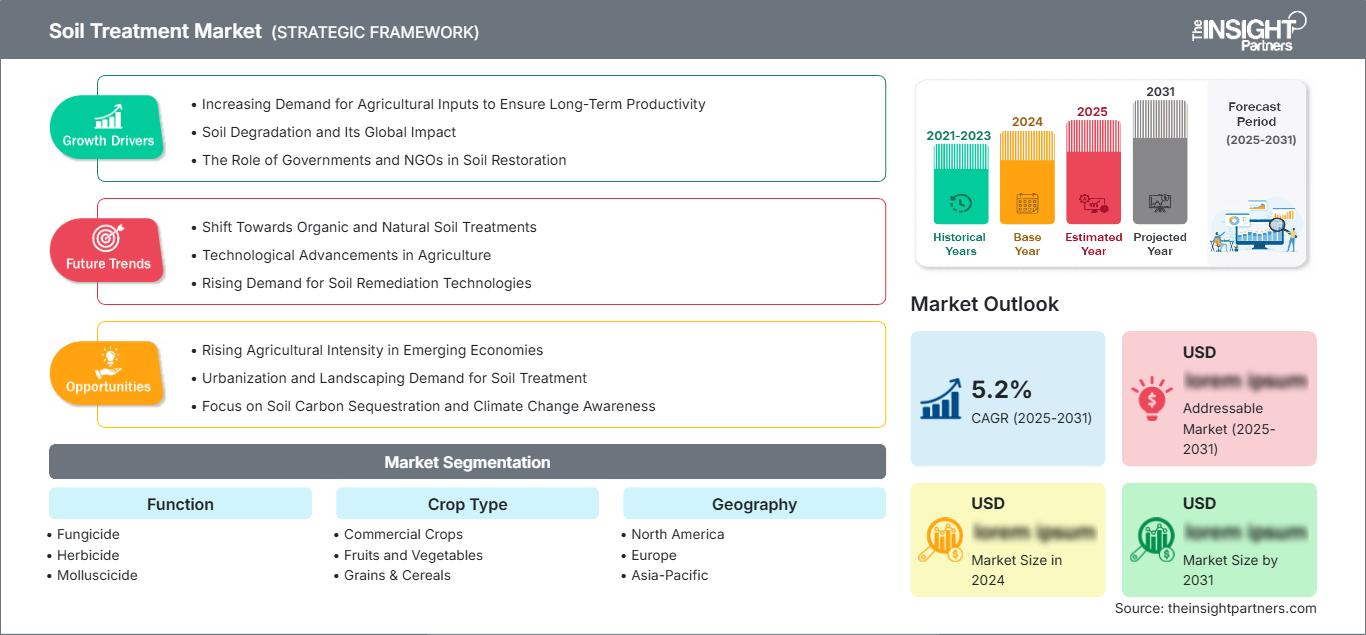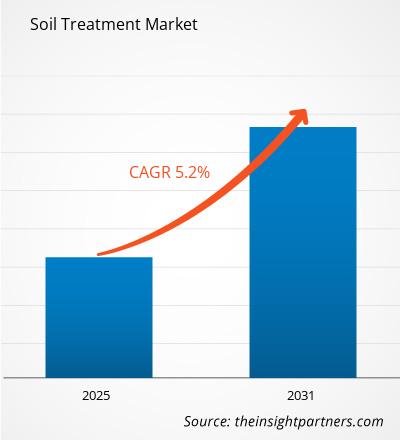Se espera que el mercado de tratamiento de suelos registre una CAGR del 5,2% entre 2025 y 2031, con un tamaño de mercado que se expandirá de US$ XX millones en 2024 a US$ XX millones en 2031.
El informe está segmentado por función (fungicida, herbicida, molusquicida, insecticida y nematicida). Además, presenta un análisis basado en el tipo de cultivo (cultivos comerciales, frutas y hortalizas, cereales, legumbres y oleaginosas, y césped y ornamentales). El informe abarca cinco regiones: Norteamérica, Europa, Asia Pacífico, Oriente Medio y África, y Sudamérica y Centroamérica, así como los países clave de cada región. El análisis global se desglosa a nivel regional y por países principales. El informe ofrece el valor en USD para el análisis y los segmentos mencionados.
Propósito del Informe
El informe "Mercado de Tratamiento de Suelos" de The Insight Partners busca describir el panorama actual y el crecimiento futuro, los principales factores impulsores, los desafíos y las oportunidades. Esto proporcionará información a diversas partes interesadas del negocio, como:
- Proveedores/fabricantes de tecnología: Para comprender la dinámica cambiante del mercado y conocer las oportunidades potenciales de crecimiento, lo que les permitirá tomar decisiones estratégicas informadas.
- Inversores: Realizar un análisis exhaustivo de tendencias respecto a la tasa de crecimiento del mercado, las proyecciones financieras del mercado y las oportunidades que existen en toda la cadena de valor.
- Órganos reguladores: Regular las políticas y las actividades policiales en el mercado con el objetivo de minimizar el abuso, preservar la confianza de los inversores y defender la integridad y estabilidad del mercado.
Segmentación del mercado de tratamiento de suelos
Función
- Fungicida
- Herbicida
- Molusquicida
- Insecticida
- Nematicida
Tipo de cultivo
- Cultivos comerciales
- Frutas y verduras
- Granos y cereales
- Legumbres y semillas oleaginosas
- Césped y plantas ornamentales
Obtendrá personalización en cualquier informe, sin cargo, incluidas partes de este informe o análisis a nivel de país, paquete de datos de Excel, así como también grandes ofertas y descuentos para empresas emergentes y universidades.
Mercado de tratamiento de suelos: Perspectivas estratégicas

-
Obtenga las principales tendencias clave del mercado de este informe.Esta muestra GRATUITA incluirá análisis de datos, desde tendencias del mercado hasta estimaciones y pronósticos.
Factores que impulsan el crecimiento del mercado del tratamiento de suelos
- Aumento de la demanda de insumos agrícolas para garantizar la productividad a largo plazo: El aumento de la población mundial y la necesidad de productos agrícolas exigen un mayor aporte de insumos al suelo para un tratamiento adecuado que garantice la productividad agrícola a largo plazo y la disponibilidad de una producción alimentaria sostenible. La fertilización, el ajuste del pH y las enmiendas orgánicas utilizadas en el tratamiento del suelo son cruciales, ya que influyen en la salud del suelo y la maximización del rendimiento de los cultivos, además de garantizar la productividad agrícola a largo plazo y el aumento de la producción. Una alta producción agrícola exige una solución más eficiente para su tratamiento.
- Degradación del suelo y su impacto global: La sobreexplotación de las tierras agrícolas, la deforestación, la industrialización y el calentamiento global asociado con la degradación del suelo amenazan al mundo. Los principales desafíos que se enfrentan en este aspecto incluyen la erosión, el agotamiento de nutrientes y la contaminación. Esto ha exigido la adopción de medidas de acondicionamiento, control y remediación del suelo, impulsando así la restauración y conservación de suelos sanos. Los gobiernos, las ONG y las industrias afiliadas a la agroindustria tienen interés en tratar el suelo como un medio para revertir los efectos negativos acumulados de su gestión inadecuada.
- El papel de los gobiernos y las ONG en la restauración del suelo: La creciente concienciación sobre los factores ambientales y las estrictas regulaciones gubernamentales relativas al tratamiento del suelo con productos agrícolas sostenibles impulsan la adopción de estos productos. Los tratamientos orgánicos y respetuosos con el medio ambiente son la opción predilecta de los agricultores, ya que minimizan el uso de productos químicos en la agricultura y evitan la contaminación del suelo y el agua. Las regulaciones agrícolas exigen que el tratamiento del suelo se ajuste estrictamente a los principios agrícolas para una agricultura segura y saludable.
Tendencias futuras del mercado de tratamiento de suelos
- Cambio hacia tratamientos orgánicos y naturales para el suelo: Los tratamientos orgánicos y naturales para el suelo, como el compost, el biocarbón y los fertilizantes vegetales, están en auge. Esto se debe a que los consumidores prefieren más productos orgánicos y a que las regulaciones ambientales más estrictas exigen una gestión del suelo no tóxica y sostenible. Los tratamientos de suelo de origen biológico también están en auge debido a su mayor respeto por el medio ambiente y seguridad en comparación con los productos químicos sintéticos.
- Avances tecnológicos en la agricultura: La adopción de nuevas tecnologías en la agricultura está transformando la forma en que se trata el suelo. El análisis de datos, los dispositivos IoT, los drones y otros sensores están dominando la capacidad de practicar la agricultura de precisión. El monitoreo oportuno de las condiciones del suelo también se realiza mediante tratamientos específicos. Estas tecnologías garantizan que los fertilizantes del suelo no se desperdicien, minimizando los residuos y logrando una eficiencia general óptima en las aplicaciones del tratamiento del suelo. Es probable que el uso de tecnologías más accesibles aumente su participación en el mercado del tratamiento del suelo.
- Creciente demanda de tecnologías de remediación de suelos: La creciente demanda de tecnologías de remediación de suelos se debe a la contaminación del suelo con metales pesados, pesticidas, residuos industriales y otros contaminantes. La creciente demanda de tecnologías de remediación ecológica, como la biorremediación y la fitorremediación, para la descontaminación y la recuperación de suelos contaminados, ha comenzado a mostrar un fuerte impulso en el mercado. Los principales impulsores de esta tendencia son una mayor conciencia ambiental, la nueva legislación sobre contaminación industrial y la necesidad de tierras limpias y saludables para la agricultura y las necesidades urbanas.
Oportunidades de mercado en el tratamiento de suelos
- Aumento de la intensidad agrícola en las economías emergentes: El aumento de la intensidad agrícola en las economías emergentes, especialmente en Asia-Pacífico, América Latina y África, está expandiendo la demanda de tecnologías de tratamiento del suelo. Los mismos problemas que aquejan a estas economías emergentes —prácticas deficientes de gestión del suelo y sobreexplotación agrícola en muchas zonas— representan oportunidades para las empresas que desarrollan tecnologías de tratamiento del suelo, como enmiendas orgánicas, control del pH y restauración de la salud del suelo.
- Demanda de tratamiento de suelos en urbanización y paisajismo: Con la creciente urbanización y comercialización, la necesidad de tratamiento de suelos en proyectos de paisajismo es cada vez mayor. Se ha convertido en un requisito esencial para favorecer el crecimiento de las plantas en condiciones urbanas adversas, desde parques urbanos hasta azoteas verdes y campos deportivos. Los acondicionadores de suelo, fertilizantes y materiales para el control de la erosión son vitales para el mantenimiento de ciudades saludables y sostenibles. Esto, a su vez, se convierte en una nueva oportunidad de desarrollo de mercado para las empresas dedicadas al tratamiento de suelos.
- Enfoque en el secuestro de carbono del suelo y la concienciación sobre el cambio climático: Junto con la creciente concienciación sobre el cambio climático, el enfoque en el secuestro de carbono del suelo aumenta de forma lenta pero constante. Entre ellos se encuentran grandes cantidades de biocarbón, compost y cultivos de cobertura, que, en consecuencia, son capaces de mejorar la capacidad de captura y almacenamiento del suelo. Estos métodos están ganando reconocimiento como parte de iniciativas más amplias de cultivo de carbono que abren nuevas vías para las empresas que desarrollan tratamientos del suelo que apoyan las iniciativas de secuestro de carbono.
Perspectivas regionales del mercado de tratamiento de suelos
Los analistas de The Insight Partners han explicado detalladamente las tendencias regionales y los factores que influyen en el mercado de tratamiento de suelos durante el período de pronóstico. Esta sección también analiza los segmentos y la geografía del mercado de tratamiento de suelos en América del Norte, Europa, Asia Pacífico, Oriente Medio y África, y América del Sur y Central.
Alcance del informe de mercado de tratamiento de suelos
| Atributo del informe | Detalles |
|---|---|
| Tamaño del mercado en 2024 | US$ XX millones |
| Tamaño del mercado en 2031 | US$ XX millones |
| CAGR global (2025-2031) | 5,2% |
| Datos históricos | 2021-2023 |
| Período de pronóstico | 2025-2031 |
| Segmentos cubiertos |
Por función
|
| Regiones y países cubiertos |
América del norte
|
| Líderes del mercado y perfiles de empresas clave |
|
Densidad de actores del mercado de tratamiento de suelos: comprensión de su impacto en la dinámica empresarial
El mercado del tratamiento de suelos está creciendo rápidamente, impulsado por la creciente demanda del usuario final debido a factores como la evolución de las preferencias de los consumidores, los avances tecnológicos y un mayor conocimiento de los beneficios del producto. A medida que aumenta la demanda, las empresas amplían su oferta, innovan para satisfacer las necesidades de los consumidores y aprovechan las tendencias emergentes, lo que impulsa aún más el crecimiento del mercado.

- Obtenga una descripción general de los principales actores clave del mercado de tratamiento de suelos
Puntos clave de venta
- Cobertura integral: el informe cubre de manera integral el análisis de productos, servicios, tipos y usuarios finales del mercado de tratamiento de suelos, proporcionando un panorama holístico.
- Análisis de expertos: el informe se compila con base en el conocimiento profundo de expertos y analistas de la industria.
- Información actualizada: El informe asegura relevancia comercial debido a su cobertura de información reciente y tendencias de datos.
- Opciones de personalización: este informe se puede personalizar para satisfacer los requisitos específicos del cliente y adaptarse adecuadamente a las estrategias comerciales.
Por lo tanto, el informe de investigación sobre el mercado de tratamiento de suelos puede ayudar a descifrar y comprender el panorama de la industria y sus perspectivas de crecimiento. Si bien existen algunas preocupaciones válidas, las ventajas generales de este informe suelen superar las desventajas.
- Análisis histórico (2 años), año base, pronóstico (7 años) con CAGR
- Análisis PEST y FODA
- Tamaño del mercado, valor/volumen: global, regional y nacional
- Industria y panorama competitivo
- Conjunto de datos de Excel
Informes recientes
Informes relacionados
Testimonios
Razón para comprar
- Toma de decisiones informada
- Comprensión de la dinámica del mercado
- Análisis competitivo
- Información sobre clientes
- Pronósticos del mercado
- Mitigación de riesgos
- Planificación estratégica
- Justificación de la inversión
- Identificación de mercados emergentes
- Mejora de las estrategias de marketing
- Impulso de la eficiencia operativa
- Alineación con las tendencias regulatorias






















 Obtenga una muestra gratuita para - Mercado de tratamiento de suelos
Obtenga una muestra gratuita para - Mercado de tratamiento de suelos